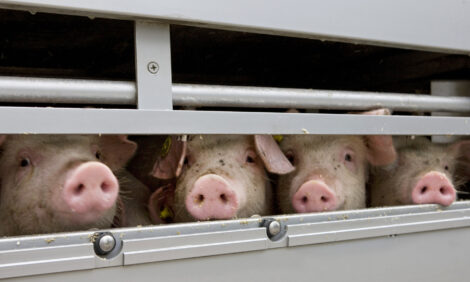



Omega-3 Fatty Acids Improve Litter Weight
US - Researchers at the Department of Animal and Food Sciences at Texas Tech University found that feeding sows a supplement of omega-3 fatty acids during lactation significantly increased the weight of their piglets in both the first and second parities. A higher protein level in the lactation diet did not affect litter weight.The study was conducted to determine the effect of dietary supplementation of omega-3 fatty acids (O3FA), with or without high levels of protein on the performance of sows during first and subsequent parity.
Sixty-four pregnant gilts with an average bodyweight of 195.0 kg (± 2.1 kg) and backfat thickness of 12.9 mm (± 0.2 mm) were assigned to four dietary treatments from day 60 of gestation (late gestation) to day 21 of lactation.
- control (CON )
- high protein (HP)
- CON + 0.2% O3FA (O3) and
- HP + 0.2% O3FA (HPO3).
For CON and O3, crude protein contents were 12.3 per cent for late gestation and 17.9 per cent for lactation and were 18.4 per cent for late gestation and 19.5 per cent for lactation for HP and HPO3.
On days 60 and 110 of gestation and after farrowing (within 12 hours post-farrowing) and on days 10 and 21 of lactation, body weight, backfat thickness and blood samples were obtained. Numbers of total and live born piglets and birth weights were measured within 12 hours post-farrowing. Colostrum and milk samples were obtained on days 2 and 21 of lactation, respectively. All piglets were weaned at 21 days. Weaning-to-oestrus interval and average daily feed intake were recorded. The same measurements were obtained from the CON and O3 groups during subsequent parity.
Dietary treatment did not affect body weight, backfat thickness, daily feed intake or weaning-to-oestrus interval of sows during their first reproductive cycle.
Supplementation of O3FA increased both 20:5n-3 and 22:6n-3 contents in (P<0.05) colostrum and mature milk. First-parity litter size and piglet body weight at birth did not differ among treatment groups. Piglet body weight was greater (P<0.05) for the O3 compared to both CON and HPO3 groups at days 10 and 21 of lactation.
The same pattern was also noted for overall piglet weight gain. Piglet and litter characteristics of the HP group did not differ from other groups throughout lactation.
During subsequent parity, both total and live piglet birth weight tended (P<0.07) to be greater for the O3 than the CON group. Compared to the CON group, O3 piglet body weight and weight gain showed a similar pattern to the previous parity.
Results indicate that O3FA alone during lactation improved growth of nursing piglets regardless of parity. However, O3FA supplemented with or without high protein did not affect first-parity gestation performance although O3FA alone may improve subsequent piglet birth weight in the subsequent litter.








